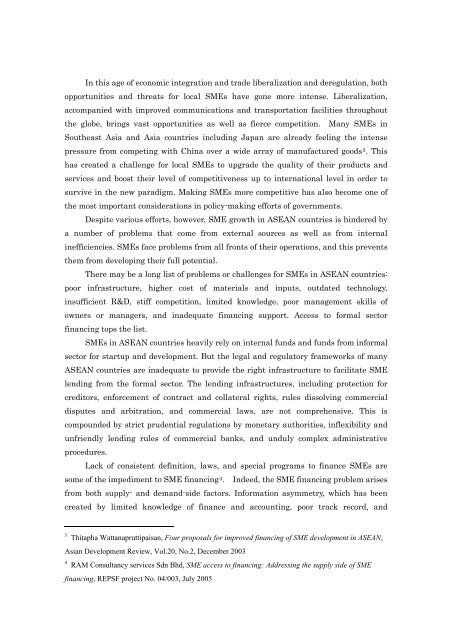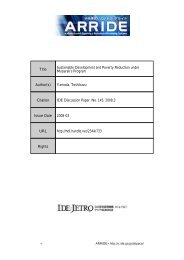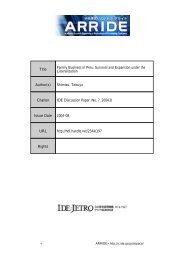Title Financing Small and Medium Enterprises in Myanmar Author(s ...
Title Financing Small and Medium Enterprises in Myanmar Author(s ...
Title Financing Small and Medium Enterprises in Myanmar Author(s ...
Create successful ePaper yourself
Turn your PDF publications into a flip-book with our unique Google optimized e-Paper software.
In this age of economic <strong>in</strong>tegration <strong>and</strong> trade liberalization <strong>and</strong> deregulation, both<br />
opportunities <strong>and</strong> threats for local SMEs have gone more <strong>in</strong>tense. Liberalization,<br />
accompanied with improved communications <strong>and</strong> transportation facilities throughout<br />
the globe, br<strong>in</strong>gs vast opportunities as well as fierce competition. Many SMEs <strong>in</strong><br />
Southeast Asia <strong>and</strong> Asia countries <strong>in</strong>clud<strong>in</strong>g Japan are already feel<strong>in</strong>g the <strong>in</strong>tense<br />
pressure from compet<strong>in</strong>g with Ch<strong>in</strong>a over a wide array of manufactured goods 3 . This<br />
has created a challenge for local SMEs to upgrade the quality of their products <strong>and</strong><br />
services <strong>and</strong> boost their level of competitiveness up to <strong>in</strong>ternational level <strong>in</strong> order to<br />
survive <strong>in</strong> the new paradigm. Mak<strong>in</strong>g SMEs more competitive has also become one of<br />
the most important considerations <strong>in</strong> policy-mak<strong>in</strong>g efforts of governments.<br />
Despite various efforts, however, SME growth <strong>in</strong> ASEAN countries is h<strong>in</strong>dered by<br />
a number of problems that come from external sources as well as from <strong>in</strong>ternal<br />
<strong>in</strong>efficiencies. SMEs face problems from all fronts of their operations, <strong>and</strong> this prevents<br />
them from develop<strong>in</strong>g their full potential.<br />
There may be a long list of problems or challenges for SMEs <strong>in</strong> ASEAN countries:<br />
poor <strong>in</strong>frastructure, higher cost of materials <strong>and</strong> <strong>in</strong>puts, outdated technology,<br />
<strong>in</strong>sufficient R&D, stiff competition, limited knowledge, poor management skills of<br />
owners or managers, <strong>and</strong> <strong>in</strong>adequate f<strong>in</strong>anc<strong>in</strong>g support. Access to formal sector<br />
f<strong>in</strong>anc<strong>in</strong>g tops the list.<br />
SMEs <strong>in</strong> ASEAN countries heavily rely on <strong>in</strong>ternal funds <strong>and</strong> funds from <strong>in</strong>formal<br />
sector for startup <strong>and</strong> development. But the legal <strong>and</strong> regulatory frameworks of many<br />
ASEAN countries are <strong>in</strong>adequate to provide the right <strong>in</strong>frastructure to facilitate SME<br />
lend<strong>in</strong>g from the formal sector. The lend<strong>in</strong>g <strong>in</strong>frastructures, <strong>in</strong>clud<strong>in</strong>g protection for<br />
creditors, enforcement of contract <strong>and</strong> collateral rights, rules dissolv<strong>in</strong>g commercial<br />
disputes <strong>and</strong> arbitration, <strong>and</strong> commercial laws, are not comprehensive. This is<br />
compounded by strict prudential regulations by monetary authorities, <strong>in</strong>flexibility <strong>and</strong><br />
unfriendly lend<strong>in</strong>g rules of commercial banks, <strong>and</strong> unduly complex adm<strong>in</strong>istrative<br />
procedures.<br />
Lack of consistent def<strong>in</strong>ition, laws, <strong>and</strong> special programs to f<strong>in</strong>ance SMEs are<br />
some of the impediment to SME f<strong>in</strong>anc<strong>in</strong>g 4 . Indeed, the SME f<strong>in</strong>anc<strong>in</strong>g problem arises<br />
from both supply- <strong>and</strong> dem<strong>and</strong>-side factors. Information asymmetry, which has been<br />
created by limited knowledge of f<strong>in</strong>ance <strong>and</strong> account<strong>in</strong>g, poor track record, <strong>and</strong><br />
3 Thitapha Wattanapruttipaisan, Four proposals for improved f<strong>in</strong>anc<strong>in</strong>g of SME development <strong>in</strong> ASEAN,<br />
Asian Development Review, Vol.20, No.2, December 2003<br />
4 RAM Consultancy services Sdn Bhd, SME access to f<strong>in</strong>anc<strong>in</strong>g: Address<strong>in</strong>g the supply side of SME<br />
f<strong>in</strong>anc<strong>in</strong>g, REPSF project No. 04/003, July 2005




![Title [書評] 廣田義人著『東アジア工作機械工業の技術形成 ... - ARRIDE](https://img.yumpu.com/47139953/1/184x260/title-arride.jpg?quality=85)






